This document provides information on how to move/migrate a CDP Server (Enterprise Edition) from one physical computer to another.
A CDP Server migration will involve these two elements:
- Old Computer - The physical machine where you have your current CDP Server installation.
- New Computer - The physical machine to which you are moving (migrating) your CDP Server.
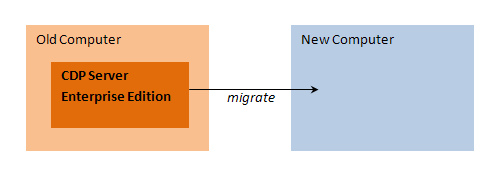
Why should I do this?
Here are two possible reasons why it may become necessary to migrate a CDP Server:
- Your current computer is having hardware problems and is no longer reliable.
- During backup/restore procedures, it becomes clear that processing power is not sufficient to perform all tasks quickly and reliably; however, the current computer cannot be scaled up any further.
Follow the instructions below to move/migrate an Enterprise Edition installation to a New Computer.
| Note It is assumed that you have prepared a New Computer according to these requirements: System Requirements - CDP Enterprise Edition for Windows and System Requirements - CDP Enterprise Edition for Linux. |
- Step 1 - Installing a New CDP Enterprise Edition Server
- Step 2 - Shutting Down the CDP Server Service
- Step 3 - Removing "log," "conf," and "data" on the New Computer
- Step 4 - Copying "log", "conf," and "data" from the Old Computer
- Step 5 - Starting the CDP Server on the New Computer
- Step 6 - Reactivating the License key
- Step 7 - Copying the Disk Safes
- Step 8 - Restarting the CDP Server on the New Computer
Step 1 - Installing a New CDP Enterprise Edition Server
First, install a new CDP Enterprise Edition Server on the New Computer. See:
Step 2 - Shutting Down the CDP Server Service
Stop the CDP Server on the New Computer.
Linux Installations
If your CDP Server is installed on Linux, then the Linux CDP Server can be stopped via the Terminal using this command:

The "cdpserver stopped" message will appear.

Windows Installations
If your CDP Server is installed on Windows, then the Windows CDP Server can be stopped via the "Services" utility. Perform the following steps.
1. Click the Windows "Start" button, and then start the "Run" program. The "Run" window will be opened.
Type in the "services.msc" command, and click the "OK" button.
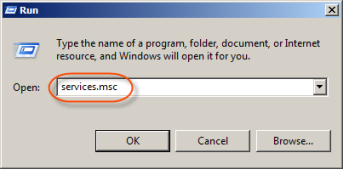
2. The "Services" window will be opened.
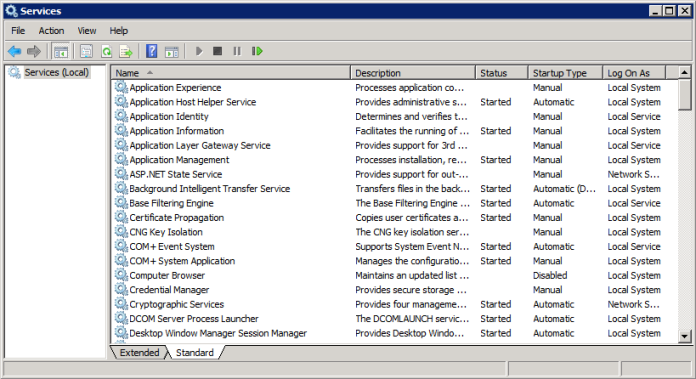
3. Find the "R1Soft CDP Server" service. Right-click on it, and then choose "Stop" in the drop-down menu. The service will be stopped.
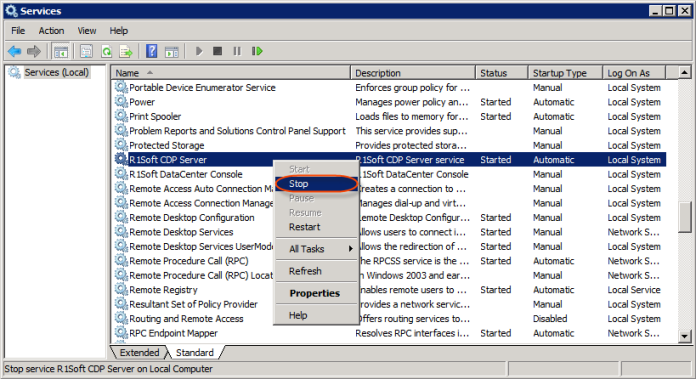
Step 3 - Removing "log," "conf," and "data" on the New Computer
The following activities should be performed on the New Computer.
Linux Installations
1. Open a terminal program on your Linux computer. Go to the CDP Server's location, and list all files and folders using these commands:
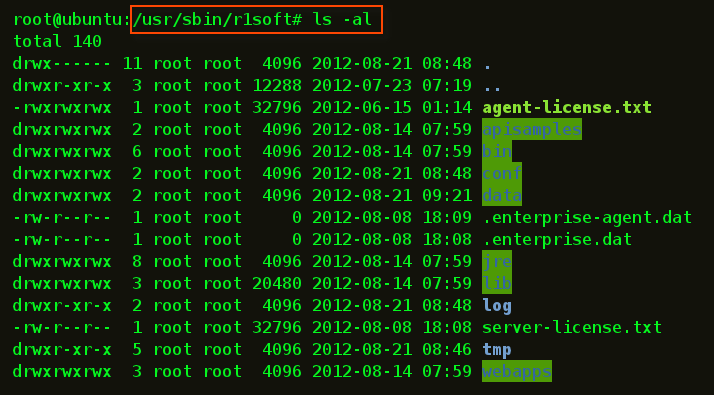
2. Remove the log, conf, and data folders using the rm command:
| Note Use the rm -r command with caution; if you mistype the directory, the command will delete everything, without asking for confirmation. Find more information here: Using rmdir and rm commands |

Windows Installations
1. Open the Windows Explorer program (e.g., click "Start"  "Run"
"Run"  %windir%\explorer.exe) or another file browser, and go here: C:\Program Files\R1Soft CDP Server Enterprise (this is the default path; in our example, CDP Server is located on the D: drive).
%windir%\explorer.exe) or another file browser, and go here: C:\Program Files\R1Soft CDP Server Enterprise (this is the default path; in our example, CDP Server is located on the D: drive).

2.Choose the conf, data, and log folders, and delete them. To do this, right-click them and choose "Delete" in the displayed context menu. The folders will disappear.
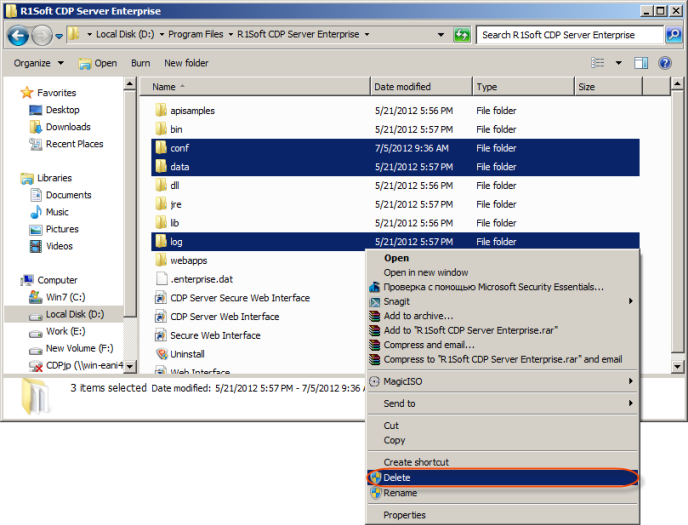
Step 4 - Copying "log", "conf," and "data" from the Old Computer
In this step, you will copy the "log", "conf," and "data" folders from the Old Computer to the New one.
Linux Installations
1. If your New Computer has an SSH daemon running, you can use the scp command for copying the "log," "conf," and "data" folders:
Explanation of this command:
- /path/to/folder/ - The Old Computer's path to the folder being copied. By default, it is /usr/sbin/r1soft/data/ for the "data" folder.
- user - The user from the New Computer who has the "Write" permission.
- targethost - The New Computer's IP address.
- /target/path/ - The New Computer's path to the folder. By default, this path is "/usr/sbin/r1soft/."
2. Type this command correctly, and then enter "yes" to confirm continuation of the connection. Then enter the user's password.
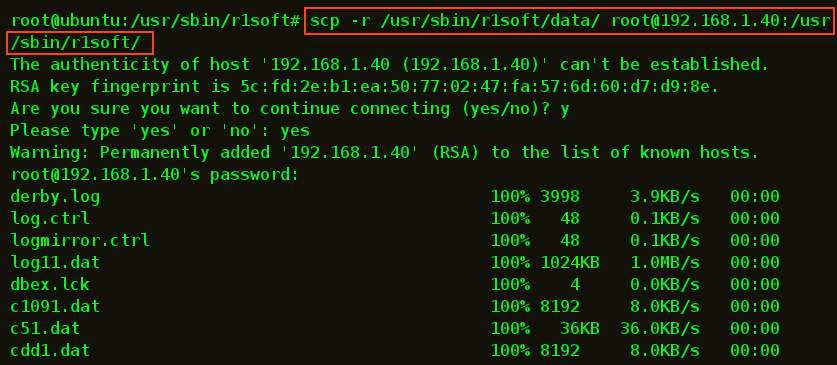
Once the folder has been copied, it can be found in the New Computer.

| Note If you are not sure about any part of this step, carefully read the information on this page: Remote file copy program |
Windows Installations
1. Open the Windows Explorer program (e.g., click "Start"  "Run"
"Run"  %windir%\explorer.exe) or another file browser, and go to C:\Program Files\R1Soft CDP Server Enterprise (this is the default path; in our example, CDP Server is located on the D: drive).
%windir%\explorer.exe) or another file browser, and go to C:\Program Files\R1Soft CDP Server Enterprise (this is the default path; in our example, CDP Server is located on the D: drive).

2. Choose the "conf," "data," and "log" folders and copy them. To do this, right-click on them and choose the "Copy" item in the displayed context menu. The folders will be copied to the Windows Clipboard.

3. Paste those three folders to the "R1Soft CDP Server Enterprise" folder on your New Computer. If your New Computer is located in the same LAN and is accessible, we assume you have full permissions (Read & Write) for the "R1Soft CDP Server Enterprise" folder.

Step 5 - Starting the CDP Server on the New Computer
The following activities should be performed on the New Computer to which you are going to migrate.
Linux Installations
The R1Soft Linux CDP Server can be started via the Terminal using this command:

The "cdpserver started" message will appear.
You can also check whether this service has been started by typing the cdp-server status command and pressing <Enter>.

Windows Installations
1. Access the "Services" window as described above in Step 2.
2. Find the "R1Soft CDP Server" service, right-click on it, and choose the "Start" command in the displayed context menu.
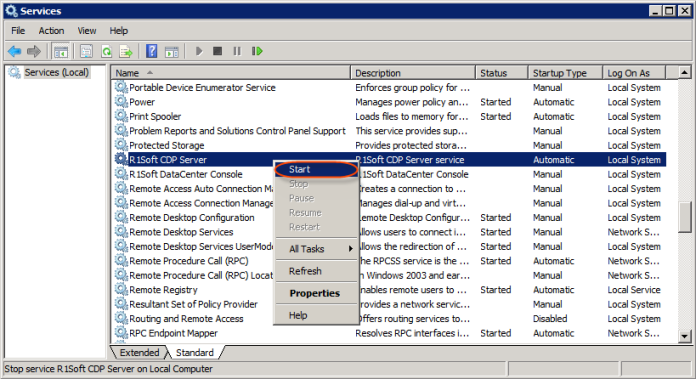
The service will be started.
Step 6 - Reactivating the License key
The following activities should be performed on the New Computer to which you are going to migrate.
This procedure is necessary and must be performed to be able to use your CDP Enterprise Edition Server's functionality.
All information concerning the License Key Reactivation can be found here: Reactivating the License
Step 7 - Copying the Disk Safes
| Note The following activities should be performed first on the Old Computer, and then on the New Computer. |
After completing this procedure, your Disk Safe data will be safely placed in the New Computer's storage.
All information concerning Disk Safe copying can be found here: Copying and Moving Disk Safes
Step 8 - Restarting the CDP Server on the New Computer
The following activities should be performed on the New Computer. This procedure is performed after the Disk Safes have been copied.
All information concerning the CDP Server restarts can be found here: Restarting CDP Server
